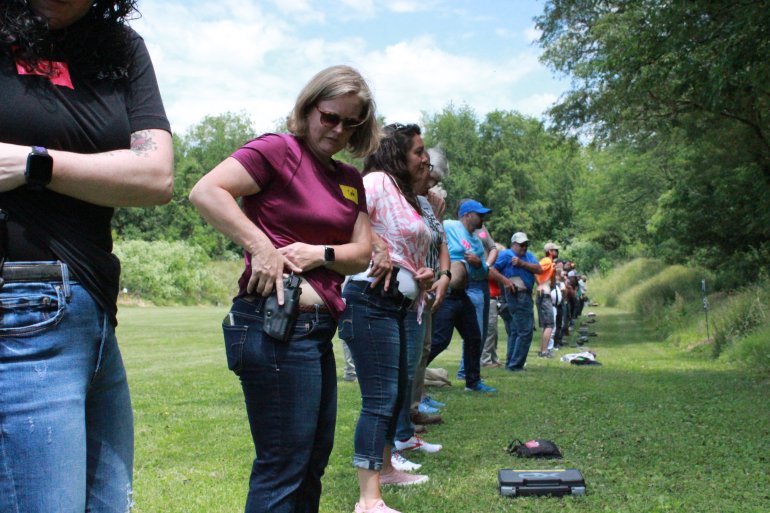
by Nick Klementzos
You want a fast draw. I want a fast draw. We all want a fast draw.
However, “fast” in this instance probably isn’t what you might think. Fast draws don’t mean moving at a high rate of speed.
I’m going to share something from the Mystical Order of Secret “Stuff” with you, but don’t tell anyone!
“Speed” in drawing a gun is a whole lot less about reflexes and quick movements, and more about efficiency. Or as some call it, economy of motion.
Yes, the biggest secret to speed is economy of motion.
The less you have to move, the faster you become.
Think about it: The shortest distance between two points is a straight line.
Don’t forget to incorporate “scan and assess” for threats as part of your practice drawing your handgun. Note how the muzzles remain pointed at the “target,” fingers well away from the trigger, as these ladies scan for other threats.
The more efficient your movement, the less time will elapse between initiating “going for your gun” and presenting it on the desired target.
When drawing, do not incorporate any more movement than necessary to draw and present your pistol to your target.
For example, don’t bring your muzzle above the intended target as you extend your arms to full extension. Some folks call that fly fishing or casting. This isn’t fishing, Sam.

Similarly, do not draw your pistol from the holster and leave muzzle below the target, and then bring it up to the target near the end of extending your arms to shoot. We call that “bowling.”
Either of these very common mistakes – casting and bowling – chew up lots of precious tenths of a second because of wasted movement introduced by the shooter.
In competition, a few tenths of a second will change your standing and maybe even win a match. In a gun battle, a few tenths of a second can determine who wins, and who dies.
So no matter your motivator for drawing faster, before you try and increase your speed by moving more quickly, instead eliminate all unnecessary movement when presenting your pistol to the target.
Through practice and repetition you can train yourself to use economy of motion in your draws, making it faster to get on target.
When drawing from the hip, your muzzle should be pointed approximately on target immediately after you “clear leather.” From there, you punch the gun straight out, maintaining the muzzle on the target the entire way to full extension of the arms for the isosceles stance.
Pro-tip: If you don’t have a knowledgeable instructor close by to critique your draw for wasted movement, you can set up your smart phone to video yourself executing a series of draws with an unloaded gun. Be creative: You can shoot some video in front of a large bathroom mirror to see both sides in a single video.
Remember, safety. safety, safety! No ammunition in your designated dry-fire areas!
Record the draws then play them back with an eye towards spotting wasted movement which eats up time. Do it from an uncovered holster, then as your skills improve, repeat the exercise clearing a cover garment and drawing from concealment.
There are some other techniques used by the best shooters to shave a bit more time off, but those come with thousands of repetitions – good repetitions – safely presenting the gun to the target without a shred of wasted movement.
And while working on your speed please remember: While fast is fancy, accuracy is final.
You need to be fast enough and accurate enough to get the job done. And the corrolary: you can’t miss fast enough.
Lastly, when it comes to reholstering, I’ll leave you with this: Take your sweet time reholstering your firearm. Never rush a reholster. Nobody ever won a gunfight with a fast reholster. Take your time and do it safely.
Good luck and practice your economy of motion. You’ll like what you see within a few practice sessions if you’re doing it right.
Take a friend to the range and work together to improve your skills and safety habits.
